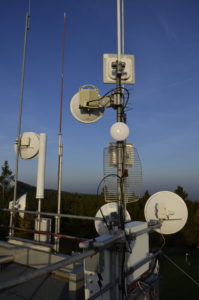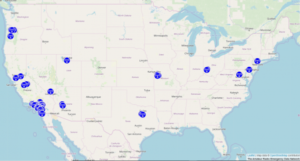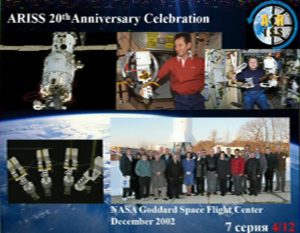One of the responsibilities of the Technical Coordinator in the Ohio Section is to submit something for the Section Journal. The Section Journal covers Amateur Radio related things happening in and around the ARRL Ohio Section. It is published by the Section Manager Scott – N8SY and articles are submitted by cabinet members.
Once my article is published in the Journal, I will also make it available on my site with a link to the published edition.
You can receive the Journal and other Ohio Section news by joining the mailing list Scott has setup. You do not need to be a member of the ARRL, Ohio Section, or even a ham to join the mailing list. Please sign up!
If you are an ARRL member and reside in the Ohio Section, update your mailing preferences to receive Ohio Section news in your inbox. Those residing outside the section will need to use the mailing list link above.
Updating your ARRL profile will deliver news from the section where you reside (if the leadership chooses to use this method).
Go to www.arrl.org and logon.
Click Edit your Profile.
You will be taken to the Edit Your Profile page. On the first tab Edit Info, verify your Email address is correct.
Click the Edit Email Subscriptions tab.
Check the News and information from your Division Director and Section Manager box.
Click Save.
Now without further ado…
Read the full edition at:
THE TECHNICAL COORDINATOR
Jeff Kopcak – TC
k8jtk@arrl.net
‘Tis the season for … regulation. The FCC and ARRL have been quite busy with proposed and amended changes affecting Part 97. Both organizations take on proposed changes brought by technical requirements, additional research, lobbying organizations (commercial and private), other laws/regulations, and of course, other hams. The FCC publishes proposed rules and invites the general public to comment on changes. Comments help decide if the FCC should enact a proposal. Once again, our allocations are under scrutiny and attack.
FCC WT Docket 19-348 and WT Docket 19-138 seeks to change 3 GHz and 5.8 GHz allocations. Nearly all allocations for the Amateur Radio Service above 220 MHz are on a secondary basis. Secondary allocations are services allowed to use the same frequency range as a primary user. A secondary user cannot cause harmful interference to primary users and cannot claim protection from primary users. Protection can only be claimed by the same or other secondary services. WT Docket 19-348 seeks to eliminate the secondary allocation of the Amateur Service on the 3 GHz frequency range. WT Docket 19-138 seeks to modify primary usage on the 5.8 GHz bands. Though not eliminating the Amateur Service secondary allocation, this would affect and restrict secondary usage.

What’s in those frequency ranges? Primarily WiFi networks. 5 or 5.8 GHz, commonly referred to as 5 GHz WiFi (not to be confused with the mobile broadband 5G standard) or the commonly known standard, 802.11ac. Consumer WiFi in both 2.4 GHz and 5 GHz are unlicensed ISM spectrum meaning you don’t need a license from a regulatory agency to use that spectrum. This is the reason you don’t need a license to operate a WiFi router or hotspot where a laptop, mobile phone, or Internet of Things device would communicate with a wireless network or the Internet. The 3 GHz spectrum is also used to create wireless networks but does require a license in other to operate. Our allocation (3.3 – 3.5 GHz, or 9-centimeter band) is just below commercial WiFi but the same equipment is modified for amateur use.
This Notice of Proposed Rulemaking (NPRM) is in response to the MOBILE NOW (Making Opportunities for Broadband Investment and Limiting Excessive and Needless Obstacles to Wireless) act passed by Congress to make new spectrum available for fixed and wireless broadband, aka your mobile phone and 5G devices. From the introduction to docket 19-348 by the FCC, “By proposing to delete the existing non-federal secondary allocations from the 3.3-3.55 GHz band in the Table of Frequency Allocations, we are taking an important initial step towards satisfying Congress’s directives and making as much as 250 megahertz of spectrum from this band potentially available for advanced wireless services, including 5G, the next generation of wireless connectivity.” “Currently, the entire 3.1-3.55 GHz band is allocated for both federal and non-federal radiolocation services, with non-federal users operating on a secondary basis to federal radiolocation services, which have a primary allocation.”
“Needless Obstacles” are apparently Amateur Radio and using that space to build out high speed networks to support Emergency Operations Centers (EOCs), non-governmental agencies (NGO), and first responders. Most notable use of the 3 GHz spectrum for Amateur Radio has been pioneered by the AREDN (Amateur Radio Emergency Data Network) group which came out of an ARRL group on High-Speed Multimedia (HSMM). For more than a decade, AREDN has developed software for a large number of commercially available wireless devices, in the $45-$95 range, allowing operation in Part 97 allocations including 900 MHz, 2, 3, and 5 GHz bands. Commonly referred to in the ham community as “Mesh” networking, these devices utilize the same protocols used on the Internet allowing served agencies connectivity to Internet-based services. Independent of Internet infrastructure, they can additionally provide video, email, voice, and chat service when the Internet is not available.
Though the proposal offers re-locating secondary services, the AREDN project has posted their response to these proposed changes citing such a move “would be difficult if not impossible without a complete redesign, manufacture, purchase, and installation of new custom Amateur hardware and software… raising the price out of reach for the typical ham.” The ARRL news posting includes information on how to file a comment on the proposal at the end of the article. An earlier post from the ARRL indicates the changes also affect satellite operations in the 3.40 – 3.41 GHz segment.
Obviously, I’m against commandeering bands and spectrum of the Amateur Radio Service. Trying to lessen the impact by seemingly providing good-will relocation assistance always comes with catches and gotchas, not-to-often many benefits. Many outlined in the AREDN post. Contributions are always of question of when, how much, and how far will it go. It’s unlikely they’re going to make any manufacturing contributions to redesign and sell new equipment at a reasonable price. Prices for mesh equipment is reasonable because of commercial interests in the 3.65 GHz licensed WiFi band. Not to mention time invested by volunteers to develop mesh technology hams have available today. Please consider commenting on the proposal or support the ARRL Spectrum Defense Fund which takes on challenges such as these and protects our operating privileges.

I’ve been in favor of the symbol rate elimination from Part 97 and adopting bandwidth limitations of 2.8 kHz on HF band data emissions – though I would like to see bandwidth limitations set across the board. Arbitrary [low] baud rates are not allowing experimentation of more innovative and spectrally efficient digital modes, and curtail experimentation with modes that can transfer the same data at a much faster rate. The ARRL has renewed its request to delete the HF symbol rates and adopt the 2.8 kHz bandwidth requirement.
The ARRL believes a proposal filed by New York University (NYU) would add further uncertainly to Section 97.113(a)(4) – prohibiting “messages encoded for the purpose of obscuring their meaning.” In relation to the deletion of symbol rates, the NYU proposal seeks to adopt language the ARRL feels could weaken the prohibition of encrypted messages. The wording “effectively encrypted or encoded messages, including messages that cannot be readily decoded over the air for true meaning.” The League has an issue with the wording “effectively encrypted.” “ARRL said that adding the word “effectively” would make the definition even more vague by including all encoded messages plus an additional set of undefined messages, the extent of which is unknown.” It has asked the FCC to dismiss the NYU petition.
The issue of encryption will continue to be a hot-button issue and will be as heated as it has become among scanner enthusiasts when disusing encryption on public safety radio systems, if not more. I completely understand and fully support the openness and transparency of Amateur Radio. However, I think there are a few issues we, as hams, need to have very solid responses when encryption comes up in discussion and in competition with other sources.
The first is privacy and security. More laws are being passed such as GDPR in Europe. It is mandated regulation around the privacy and protection of European Union citizens including data collection, retention, disclosures – and encryption standards. On the heels of that regulation, many states have passed similar laws mirroring those compliance requirements. I see us (hams) sitting at the table with served agencies. Some representative has mandated some form of encryption on network links and retaining control of data. Is ham radio now off the table? Probably depends on the wording. What is our answer when commercial entities are pushing their “first responder” networks and reserved bandwidth that can offer data encryption and protection? Is the expectation of coding patient data into TAG IDs good enough? Does it keep ham radio relevant because we can’t offer encryption and why? Proposals to modify the obfuscation requirements of Part 97 have pointed to such requirements or potential requirements by served agencies. I guarantee we have not seen the last of these arguments.
Experimentation side of ham radio is another issue. I have seen the maker movement as a way to bring younger and like-minded people into the hobby. If these technically minded individuals are experimenting with technologies that probably offer some form of encryption by default, how can ham radio win at this argument? Why would they choose a non-encrypted method when there are readily available encryption methods and they are becoming the foundation for newer technologies? Maybe the thought of being able to use higher power or not as crowded spectrum might be an incentive. To me, it’s not an issue of ‘what are they hiding’ or ‘why do they need encryption.’ Technical (ie: Information Technology, I.T.) professionals are opting for security and encryption instinctively. Technical individuals and the industry have conditioned average users to look for secure options such as checking for the green lock on websites and using “secured” WiFi networks. Vint Cerf, considered to be the father of the Internet, reflected on the progression of the Internet by stating “If I could start over again I would have introduced a lot more strong authentication and cryptography into the system.” How would that have affected ham radio TCP networks? Maybe those who would utilize ham radio for their experimentation purposes just don’t want someone else peering into their information exchange or use it as a method of authentication, not necessarily hiding something.
In a devil maybe in the details change, the FCC modified Part 97 RF exposure safety rules. Current safety limits will remain unchanged. The amateur-specific exemption from having to conduct an RF exposure evaluation will be replaced by the FCC’s general exemption criteria. Certain stations are exempted from having to conduct evaluations based only on power and frequency. The Commission indicated that if the source was excluded from routine evaluations under the old rules, they will be exempt under the new rules. From the ARRL news release: “For applicants and licensees in the Amateur Radio Service, we substitute our general exemption criteria for the specific exemption from routine evaluation based on power alone in Section 97.13(c)(1) and specify the use of occupational/controlled limits for amateurs where appropriate,” the FCC said. “RF exposure of other nearby persons who are not members of the amateur licensee’s household must be evaluated with respect to the general population/uncontrolled exposure limits. Appropriate methodologies and guidance for evaluating Amateur Radio Service operation is described in the Office of Engineering and Technology (OET) Bulletin 65, Supplement B,” the revised rule concludes. Further review by ARRL technical, legal staff, and ARRL RF Safety experts is needed to determine any changes in requirements.

In 2017, Norway was the first country to shut off FM broadcasts in favor of Digital Audio Broadcasting (DAB). In North America, we use the HD Radio standard. Not amateur related, but interestingly the FCC is seeking comments on a NPRM allowing AM broadcasters to voluntary change to an all-digital broadcast. “We tentatively conclude that a voluntary transition to all-digital broadcasting has the potential to benefit AM stations and provide improved AM service to the listening public,” the FCC said. “We seek comments on proposed operating standards for all-digital stations and the impact of such operations on existing analog stations and listeners.” We’ll see where this goes. This maybe an incentive for low-power AM stations to move to HD Radio. I didn’t think there were many AM HD Radio stations. This was confirmed by HD Radio – Find Stations that indicated there were about a half-dozen total in the major cities of Ohio. I also wonder how HD Radio will work with signal fading or can it be received at a great distance from cities like Chicago, New York, or Nashville. Instead of being able to receive AM radio with a crystal set or HF radio, you might need a computer for some stations in the near future.
 I usually don’t get to publish ISS Slow-Scan TV events in advance because they are often last minute and at the mercy of crew availability. There was an announcement of a possible SSTV event starting December 27 or 28 of this year. No special setup is required to copy images, even an HT can be a crude way to receive. To receive the best images, Yagi antennas on a tracking tripod is best. I just use my external VHF antenna and let the computer listen for transmissions. To receive SSTV images, the popular choice for Windows is MMSSTV and QSSTV for Linux. Tune a radio to 145.800 MHz FM and wait for the ISS images to appear on screen. I have tutorials available to help get your station setup and get started with MMSSTV for more details on receiving images.
I usually don’t get to publish ISS Slow-Scan TV events in advance because they are often last minute and at the mercy of crew availability. There was an announcement of a possible SSTV event starting December 27 or 28 of this year. No special setup is required to copy images, even an HT can be a crude way to receive. To receive the best images, Yagi antennas on a tracking tripod is best. I just use my external VHF antenna and let the computer listen for transmissions. To receive SSTV images, the popular choice for Windows is MMSSTV and QSSTV for Linux. Tune a radio to 145.800 MHz FM and wait for the ISS images to appear on screen. I have tutorials available to help get your station setup and get started with MMSSTV for more details on receiving images.
Thanks for reading. Happy holidays, Merry Christmas, and Happy New Year!
73… de Jeff – K8JTK
